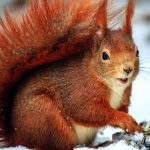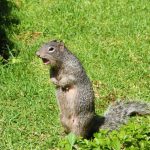Quick Navigation
If you reside near a park or on a farm, you’ve probably seen some squirrels scurrying around with nuts in their mouth.
They gather the nuts from all over and bury them in secret spots for future use.

The action of these cute bushy-tailed creatures is purely instinctive and begins in the fall when the weather starts to chill.
This article aims to reveal why squirrels go to such lengths to secure nuts and end up burying them in the ground.
The Logic Behind The Burying
Squirrels are part of a group of animals known for hoarding – this is when animals store food for future consumption.
These animals employ two strategies to store their food. They larder hoard – gather the food in one spot – or scatter hoard – split up the food to keep in several locations.
Squirrels employ the scatter hoard strategy. There are many reasons for using this strategy, and it would be discussed later in the article.
Reasons For Burying The Nuts
When people observe the large-scale scavenger hunt squirrels perform when searching for their buried nuts, it makes them question why the animals buried them in the first place. Here are the major reasons why squirrels bury nuts
1. Preparation For Scarcity During The Winter Season
Squirrels’ main diet comprises acorns, insects, seeds, mushrooms, berries, pecans, almonds, peanuts, and various other types of nuts.
The bulk of their diet is generally scarce during the winter months, and if squirrels don’t prepare for it, they will die from starvation.
Squirrels instinctively prepare for the coming winter hardships by burying – caching – nuts in secure locations not too far from their nest.
Squirrels do not hibernate, but their activities are minimal during winter. They only venture out of their nest to find their caches.
This is one of the factors responsible for most wild squirrels’ short lifespan.
One in five baby squirrels do not survive their first winter, and only half of the survivors make it past the second winter.
Without extensive preparation, the squirrels would have difficulty making it through winter.
As a form of preparation for the cold months when food will be scarce, squirrels stash nuts.
They mostly do this during autumn, when food is abundant and they have plenty of time to collect before winter comes.
Squirrels dig small holes in the soft earth to bury their prize and pat the soil down on top to keep birds away.
2. Protecting Their Reserves From Other Squirrels
For squirrels, winter comes with many struggles, and one of them is the pilfering habits of their fellow squirrels.
This is especially common among grey squirrels.
They lose about 30% of their stored food to squirrels within their community.
To combat nut theft, squirrels have had to develop tactics that help reduce their stash discovery.
The first tactic is scatter hoarding. It would be disastrous if a squirrel stores all its nut in a single location and another discovers it.
The thieving squirrel would raid the stash and transport the nuts to other areas, leaving the original owner stranded and hungry during winter.
With scatter hoarding, the squirrel stores its food in separate locations and would still have options when some of its stashes are pilfered.

The second tactic is deceptive caching. To prevent detection of their stash’s original location, squirrels create false stashes.
They dig holes similar to those they create for their nuts and hide the nuts in their mouths. They then pretend to throw the nuts into the hole.
This is done to deceive any squirrel watching. The squirrel then runs to another location to truly store the nut.
Pilfering squirrels usually have to go through many false stashes before they discover the real ones.
The third tactic involves hiding the nuts in challenging areas such as muddy areas and under bushes.
The stress involved in recovering the nuts discourages the pilfering squirrels.
3. Performing A Role In The Ecology
Squirrels unintentionally plant the foods they store. The process of caching is similar to the dribbling method of sowing.
The squirrels dig up about 3 centimeters of the soil, drop the nuts, and then cover it up.
They bury an average amount of 10,000 nuts per year and only end up eating about 4,000.
The others either germinate, remain undiscovered, or are stolen by pilfering squirrels.
Squirrels try to prevent germination by breaking the nuts before they bury them.
But whenever the nuts remain in the soil until the next spring, it grows when germination conditions are met.
This plays a vital role in the ecosystem as the squirrels create an unending supply of food for themselves and their descendants.
Uncovering The Nuts
Contrary to popular belief, squirrels do not recover most of their stored nuts by smell.
They can smell the nuts when they are very close to the stored location.
However, they do not actually smell those locations from far distances.
Squirrels create their caches within a 7acre radius. This is as big as five football fields, and squirrels can’t smell that far.
They discover their buried food through spatial memory.
Squirrels bury their food close to landmarks and create a cognitive map to connect their various locations.
They also uncover and rebury their food to refresh their memory about the locations.
Spatial chunking is a mnemonic technique used by squirrels to store their food according to type, taste, nutritional value, and size.
They store a particular type of food in one location, and when hungry, they know where to go when craving a specific type of food.
Conclusion
Squirrels in the wild have an average lifespan of 11 months to 6 years, while domesticated squirrels live for about 20 years.
The difference between both types of animals is their exposure to predators, protection from harsh weather, and most importantly, food availability.
Their parents do not teach younger squirrels how to determine which nut to store and which to eat.
The babies do it based on instinct but find it difficult to cope in their first and second winters.
If you notice a squirrel’s nest during winter, you can help out by placing some nuts on the nest tree’s foot.
They will find the nuts and keep them within their nest for easy accessibility.

Zoey is a long-time pet owner and animal rights advocate, a vital part of Purrfect n’ Pawesome. She shares her unique experiences and learnings with her readers to enhance their understanding of pet behavior and nutrition. Along with being an active pet writer, she volunteers at multiple animal shelters, rescue centres with some bespokenly awesome pets.
Zoey has a lot to share when raising the pets and spending life being their true friends. She has a quite pampered Persian cat and a Ragdoll, whom she loves the most. Readout her blogs to know more about being a responsible parent to your beloved pets.
“I love to be around cats and dogs; that’s my passion and my trick to get away from all the negativity and soaking in unconditional love and affection. Being attached to this platform gives me the reason to be vocal about pet love, care, and nurturing. Although I am not an expert or veterinarian by any means, I have a lot of experience and learnings to share with my fellow readers.”





